Islam in Palestine
Islam is a major religion in Palestine, being the religion of the majority of the Palestinian population. Muslims comprise 85% of the population of the West Bank, when including Israeli settlers,[1] and 99% of the population of the Gaza Strip.[2] The largest denomination among Palestinian Muslims are Sunnis at 85% (mostly Shafi'i) and another 15% are non-denominational Muslims.
| Islam by country |
|---|
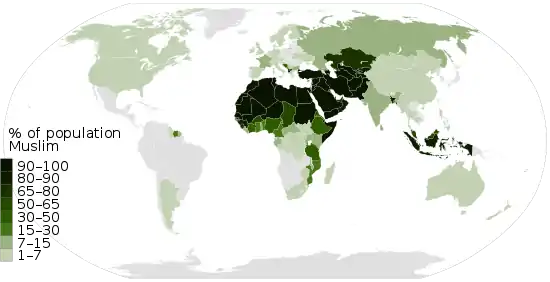 |
|
|
History
Early Islamization

Islam was brought to the region of Palestine during the Early Muslim conquests of the 7th century, when armies of the Rashidun Caliphate under the leadership of ʿUmar ibn al-Khattāb defeated the armies of Persia and the armies of the Byzantine Empire and conquered Persia, Mesopotamia, Shaam,[lower-alpha 1] Egypt, North Africa and Spain.[6]
The Muslim army conquered Jerusalem, held by the Byzantine Romans, in November, 636. For four months the siege continued. Ultimately, the Orthodox Patriarch of Jerusalem, Sophronius, agreed to surrender Jerusalem to Caliph Umar in person. Caliph Umar, then at Medina, agreed to these terms and traveled to Jerusalem to sign the capitulation in the spring of 637. Sophronius also negotiated a pact with Caliph Umar, known as the Umariyya Covenant or Covenant of Omar, allowing for religious freedom for Christians in exchange for jizyah (Arabic: جِـزْيَـة), a tax to be paid by conquered non-Muslims, called "dhimmis." Under Muslim Rule, the Christian and Jewish population of Jerusalem in this period enjoyed the usual tolerance given to non-Muslim theists.[7] [8]
Having accepted the surrender, Caliph Umar then entered Jerusalem with Sophronius "and courteously discoursed with the patriarch concerning its religious antiquities". When the hour for his prayer came, Umar was in the Anastasis, but refused to pray there, lest in the future the Muslims should use that as an excuse to break the treaty and confiscate the church. The Mosque of Omar, opposite the doors of the Anastasis, with the tall minaret, is known as the place to which he retired for his prayer.
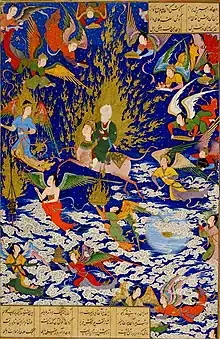

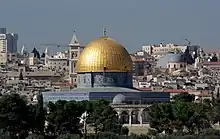
Jerusalem is Islam's third holiest city after Mecca and Medina in Saudi Arabia.[10] Although the Koran does not clarify from where exactly Muhammad ascended to Heaven, the Haram al Sharif (Temple Mount) of Jerusalem is believed by Muslims to be the location. According to the tradition, during a single night around the year 621 CE, the Islamic prophet Muhammad was carried by his mythological steed "al-Burāq" from Mecca to the Temple Mount in Jerusalem. According to the tradition, from there he ascended to heaven where he spoke with Allah. This widely accepted Islamic belief is a source of the religious and spiritual importance of the Dome of the Rock and the adjacent al-Aqsa Mosque.[11]
According to the historian James William Parkes, during the first century after the Muslim conquest (640–740), the caliph and governors of Syria and the Holy Land ruled entirely over Christian and Jewish subjects. He further states that apart from the Bedouin in the earliest days, the only Arabs west of the Jordan were the garrisons.[12]
Bishop Arculf, whose account of his pilgrimage to the Holy Land in the 7th century, De Locis Sanctis, written down by the monk Adamnan, described reasonably pleasant living conditions of Christians in Palestine in the first period of Muslim rule. The caliphs of Damascus (661–750) were tolerant princes who were on generally good terms with their Christian subjects. Many Christians (e.g. St. John Damascene) held important offices at their court. The Abbasid caliphs at Baghdad (753–1242), as long as they ruled Syria, were also tolerant of the Christians. Harun Abu-Ja-'afar, (786–809) sent the keys of the Holy Sepulchre to Charlemagne, who built a hospice for Latin pilgrims near the shrine.
Islamization under Abbasids and Fatimids
Islam became the majority religion in Palestine in the 9th century, with acculturation of the locals into Arab identity and when Arabic became the lingua franca.[13] In the Middle East and North Africa regions in general and the region of Palestine in particular, indigenous peoples in various regions who until then spoke mostly Greek, Aramaic-Syriac, Coptic and Berber, began adopting the Arabic language and the culture associated with it.
Rival dynasties and revolutions led to the eventual disunion of the Muslim world. During the 9th century, Palestine was conquered by the Fatimid dynasty, centered in Egypt. During that time the region of Palestine became again the center of violent disputes followed by wars, since enemies of the Fatimid dynasty attempted to conquer the region. At that time, the Byzantine Empire continued trying to recapture the territories they previously lost to the Muslims, including Jerusalem. The Christian inhabitants of Jerusalem, who expressed their support to the Byzantine Empire were killed by the Muslim authorities. Palestine once again became a battleground as the various enemies of the Fatimids attacked. At the same time, the Byzantine Romans continued to attempt to regain their lost territories, including Jerusalem. Christians in Jerusalem who sided with the Romans were put to death for high treason by the ruling Muslims. In 969, the Patriarch of Jerusalem, John VII, was put to death for treasonable correspondence with the Romans.
During the Fatimid era, the cities of Jerusalem and Hebron became prime destinations for Sufi wayfarers.[14] The creation of locally rooted Sufi-inspired communities and institutions between 1000 and 1250 were part and parcel of the conversion to Islam.[14]
The sixth Fatimid caliph, Caliph Al-Hakim (996–1021), who was believed to be "God made manifest" by the Druze, destroyed the Holy Sepulchre in 1009. This powerful provocation started the near 90-year preparation towards the First Crusade.[15]
In the run up to the Crusader Kingdom of Jerusalem (1099–1291), the growing importance of Jerusalem in the Muslim world manifested in less tolerance towards the other faiths. The Christians and the Jews in Palestine were persecuted and many Churches and Synagogues were destroyed. This trend peaked in 1009 when Caliph al Hakim of the Fatimid dynasty, destroyed also the Church of the Holy Sepulchre in Jerusalem. This provocation ignited enormous rage in the Christian world, which led to the Crusades from Europe to the Holy Land.
Early Crusades
In 1099, the Christian Crusaders, with the support of the Roman Catholic Church, launched the First Crusade campaign with the aims of regaining control of Jerusalem from the Fatimid Caliphate, and helping the Byzantine Empire fight the Seljuk Turks. During the campaign, the Crusaders launched an assault on the city of Jerusalem, captured it in July 1099, massacred many of the city's Muslim and Jewish inhabitants, and established the first Christian Kingdom of Jerusalem. The Crusaders transformed the Dome of the Rock into the "Shrine of the Lord" (Templum Domini) and the Al-Aqsa mosque into the "Hall of Solomon" (Templum Solomonis). The local Muslim reaction was to try to find an accommodation with the Crusaders. During this era, the larger Muslim world looked upon the setbacks in Jerusalem with indifference.[16][17][18][19]
Ayyubid rule and Late Crusades

In 1187, the Ayyubid Sultan Salah ad-Din led his armies to win a great victory over the Crusaders in the Battle of Hattin.[20] As a direct result of the battle, Islamic forces once again became the dominant power in the region, re-conquering Jerusalem and several other Crusader-held cities.[21] In 1189, the first lodge for Sufi ascetics was established at the Al-Khanqah al-Salahiyya Mosque in Jerusalem, which had been a palace of the Latin Patriarch prior to the reconquest of the city.[14]
The Christian defeat led to a Third Crusade aimed to regain the lost territories in the Holy Land. Richard I of England (Richard the Lionheart) launched a siege upon the city of Acre, after which he conquered the city and killed 3,000 Muslims. After a second victory won in the Battle of Arsuf, the Crusaders arrived to Jerusalem, but withdrew without trying to conquer the city. Following another military clash in Jaffa, which wasn't won by either side, Saladin and Richard the Lionheart signed the Treaty of Ramla in June 1192. Under the terms of the agreement, Jerusalem would remain under Muslim control but the city would be open to Christian pilgrims. The treaty reduced the Latin Kingdom to a strip along the coast from Tyre to Jaffa.
Mamluk domination
In 1250, the Ayyubid Egyptian dynasty was overthrown by slave ("Mamluk") regiments, and a new dynasty - the Mamluks - was born. On September 3, 1260, at the Battle of Ain Jalut held in the Jezreel Valley, the Muslim Egyptian Mamluks under Baibars defeated the Mongols and stopped their advance. His successor Al-Ashraf Khalil completed the victory by sweeping the last of the Crusaders out of Palestine.
In 1291, the forces of the Mamluk Sultan of Egypt al-Ashraf Khalil forced a long siege upon the city of Acre, which was the final Christian landhold in the Holy Land. The Mamluks captured the city on May 18, 1291, killing most of the Christian local inhabitants, thus ending the second Crusader Kingdom of Jerusalem.[22]
The Mamluks were to rule Palestine for the following two centuries (1291-1516). The Muslim population became the majority, and many Muslim shrines were built such as Maqam al-Nabi Yamin, Maqam al-Nabi Musa, Maqam al-Nabi Rubin and many more shrines that Muslims described as a burial sites of Prophets, Sahabas and even what they considered holy Muslim martyrs from Crusader and pre-Crusader times. Some historians say that the shrines were built to make a good strategic positions for Muslims (for example Nabi Musa was built on the road from Jerusalem to Jericho).
The Mamluks, ruling from Damascus, brought some prosperity to the area, particularly to Jerusalem, with an extensive programme involving the building of schools, hospices for pilgrims, the construction of Islamic colleges and the renovation of mosques. Mujir al-Din's extensive writing about 15th century Jerusalem documents the consolidation and expansion of Islamic sites in the Mamluk era.[23]
The ascendency of the Burji over the Bahri Mamluks, together with recurrent droughts, plagues and pestilence like the Black Death and taxation to cover the costs of wars against Crusaders and Mongols (the last of which was "Tamurlane's horde") brought about both growing insecurity and economic decline. By the end of their reign, with the decay of internal control and massive population losses due to plagues, Bedouins moved in to take advantage of the decline in defenses, and farmers abandoned their lands. They sacked Ramla in 1481 and annihilated a Mamluk army that had been raised in Gaza to repel them.[24][25] By the end of the 15th century, Jerusalem's population amounted to approximately 10,000, mostly Muslims, with roughly 1,000 Christians and 400 Jews.[26]
Rise of the Ottomans
On August 24, 1516, at the Battle of Marj Dabiq, the Ottoman Empire forces defeated the Mamluk sultanate forces and thus the Ottomans became the new rulers of the Levant. On October 28 they defeated the Mamluk forces once more in the Battle of Yaunis Khan and they annexed the region of Palestine. By December of that year the entire region of Palestine was conquered by the Ottoman Empire. As a result of the Ottoman advance during the reign of Selim I,[27] the Sunni Ottoman Turks occupied the historic region of Palestine. Their leadership reinforced and ensured the centrality and importance of Islam as the dominant religion in the region. Swamps with the risk of malaria made it difficult to settle and farm on the coastal plains and in the valleys throughout most of the Ottoman era.[28]
In 1834, a popular uprising erupted against the rule of Wāli Muhammad Ali. The main cause of the uprising was indignation at being drafted by the Egyptian army. At first the rebels managed to take over many cities, including Nablus, Jerusalem and Hebron. In response, Egyptian military leader Ibrahim Pasha commanded an army force of 40,000 people against the rebels and managed to put an end to the rebellion, conquering Gaza, Ramleh, Jaffa, Haifa, Jerusalem and Acre. Ibrahim Pasha's conquests had a significant demographic change as the region of Palestine had an influx of Muslim tribal immigrants.[29] Ibrahim Pasha, in wresting control of Palestine from the Ottoman Empire, clashed with the regional ambitions of the European Great Powers and, in order to assuage their unease, he reversed Ottoman policy and opened the country up to both foreigners and non-Muslim populations. Despite the brevity of Egyptian overlordship, since the great powers restored the fortunes of the Ottomans and their sovereignty over Palestine, the long term effect was to lay the groundwork for the development of extensive European activities and interests in Palestine.[30]
In 1860, the Mosque of Omar was built in the Christian city of Bethlehem. It is the only mosque in Bethlehem's old city.[31]
Islam during British rule
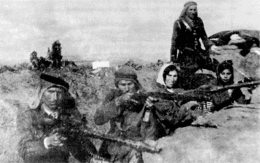
In 1917, at the end of the First World War, the British Empire conquered the region of Palestine from the Ottoman Empire. The United Kingdom was granted control of Palestine by the Versailles Peace Conference which established the League of Nations in 1919 and appointed Herbert Samuel, a former Postmaster General in the British cabinet, who was instrumental in drafting the Balfour Declaration, as its first High Commissioner in Palestine. The British occupation of the region brought an end to hundreds of years of successive Muslim rule in the region of Palestine.
The gradual increase in the number of Jews in Palestine led to the development of a proto-Arab-Palestinian national movement, influenced and inspired by Muslim leader and Mufti of Jerusalem Haj Amin al-Husseini. Zionism, the ideology advocating the creation of a Jewish state in Palestine, was increasingly identified as a threat by the Muslim-Arab population in Palestine. This anti-Zionist trend became linked to a fierce anti-British resistance (like in the 1920 Palestine riots and during the 1936–39 Arab Revolt).
The High Commissioner of Palestine, Herbert Samuel, issued an order in December 1921 establishing a Supreme Muslim Council with authority over all the Muslim waqfs and sharia courts in Palestine. In addition, in 1922 the British authorities appointed Haj Amin al-Husseini as the Mufti of Jerusalem. Until the 1936–39 Arab revolt in Palestine took place, the Council operated as the Governing body of the Arab community under the British Mandate, and co-operated with the British government in Palestine. All along its operation, the Supreme Muslim Council advocated an active resistance against the Jewish "Yishuv", supporting the Arab underground anti-British movements in the country.[32]
1948–1967: Islam under Israeli, Jordanian and Egyptian rule
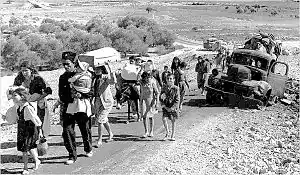
On May 14, 1948, one day before the end of the British Mandate of Palestine, the leaders of the Jewish community in Palestine led by prime minister David Ben-Gurion, made a declaration of independence, and the state of Israel was established. Contingents of Egyptian, Syrian, Jordanian, and Iraqi armies invaded Israel, thus starting the 1948 Arab–Israeli War. The nascent Israeli Defense Force repulsed the Arab nations from part of the occupied territories, thus extending its borders beyond the original UNSCOP partition.[33] By December 1948, Israel controlled most of the portion of Mandate Palestine west of the Jordan River. The remainder of the Mandate consisted of Jordan, the area that came to be called the West Bank (occupied by Jordan), and the Gaza Strip (occupied by Egypt). Prior to and during this conflict, 700,000[34] Palestinians Arabs fled their original lands to become Palestinian refugees, in part, due to a promise from Arab leaders that they would be able to return when the war is won.[35]
The British transferred the symbolic Islamic governance of the land to the Hashemites based in Jordan, and not to the House of Saud. The Hashemites thus became the official guardians of the Islamic holy places of Jerusalem and the areas around it. Following the Jordanian rule of the West Bank during the war, King Abdullah I of Jordan removed Amin al-Husayni as Grand Mufti and appointed Sheikh Hussam ad-Din Jarallah as the new Grand Mufti of Jerusalem on 20 December 1948. The Supreme Muslim Council was eventually disbanded in 1951 by the Jordanian authorities. On July 20, 1951 king Abdullah of Jordan was assassinated while visiting the Al Aqsa Mosque. The assassination was carried out by a Palestinian from the Husseini clan. The Palestinian gunman, motivated by fears that king Abdullah would make a separate peace with Israel, fired three fatal bullets into the King's head and chest.
After the conquest of the Temple Mount during the Six-Day War, the Chief Israeli Rabbinate announced that Jewish people are forbidden of entering the Temple Mount. Since 1967, Israel controls the security on the Temple Mount, but the Muslim Waqf controls administrative matters, taking responsibility for the conduct of Islamic affairs just as it did during the Jordanian rule.[36][37]
Demographics
Islam
Today Islam is a prominent religion in both Gaza and the West Bank. Most of the population in the State of Palestine are Muslims (85% in the West Bank and 99% in the Gaza Strip).[38][39]
Sunni Islam
Sunnis constitute 85% of Palestinian Muslims,[40] of which the predominant madhab is Shafi'i Islam, which is one of the four schools of Islamic law in Sunni Islam. Salafism took root in Gaza in the 1970s, when Palestinian students returned from studying abroad at religious schools in Saudi Arabia. A number of Salafi groups in Gaza continue to receive support and funding from Riyadh.[41]
Shia Islam
From 1923 to 1948, there were seven villages in Mandatory Palestine in which the population was predominantly Shia Muslim (also known as Metawali): Tarbikha, Saliha, Malkiyeh, Nabi Yusha, Qadas, Hunin, and Abil al-Qamh.[42] These villages were transferred from the French to the British sphere as a result of the border agreement of 1923. All of them were depopulated during the 1948 Arab-Israeli War and their former locations are now in northern Israel. The 1931 census counted 4,100 Metawalis in Palestine.[43]
Since 1979, due to Iran's influence, some Palestinian Sunnis have converted to Shia Islam. Israeli Haaretz reported in 2012 that Hamas's fear of growing Iranian influence in Gaza caused the organization to crack down on Shiite organizations, including charities.[44] Nevertheless, becoming Shiite is a growing trend in the Gaza Strip. Hundreds of Sunnis, both Islamic Jihad activists and ordinary people, are known to have converted.[44] The Sabireen Movement was created in 2014 by some Shi’ites that left the Islamic Jihad.[45]
Qadianism
Ahmadiyya is a small sect in Palestine. The community, which is not recognized as Islamic by mainstream Muslims, faces persecution and experiences matrimonial restrictions imposed by local Sharia courts. Although no estimates are available, reports suggest that there may be "dozens" of Palestinian Ahmadis in the West Bank.[46]
Non-denominational Islam
According to the Pew Research Center, non-denominational Muslims constitute 15% of the Palestinian Muslim population.[40]
See also
- Muslim conquest of the Levant
- Islam in Israel
- Palestinian nationalism
- Time periods in the Palestine region
- Islamization
- History of Israel
- History of Palestine
- Tsvi Misinai
- Spread of Islam
- Muslim conquests
- Islamization of Jerusalem
- Islamization of East Jerusalem under Jordanian rule
- Islamization of the Temple Mount
- Islamization of Gaza
Notes
- Ash-Shām (Arabic: اَلـشَّـام) is a region that is bordered by the Taurus Mountains of Anatolia in the north, the Mediterranean Sea in the west, the Arabian Desert in the south, and Mesopotamia in the east.[3] It includes the modern countries of Syria and Lebanon, and the land of Palestine.[4][5]
References
- West Bank. CIA Factbook
- Gaza Strip. CIA Factbook
- Killebrew, A. E.; Steiner, M. L. (2014). The Oxford Handbook of the Archaeology of the Levant: C. 8000-332 BCE. OUP Oxford. p. 2. ISBN 978-0-19-921297-2.
The western coastline and the eastern deserts set the boundaries for the Levant ... The Euphrates and the area around Jebel el-Bishrī mark the eastern boundary of the northern Levant, as does the Syrian Desert beyond the Anti-Lebanon range's eastern hinterland and Mount Hermon. This boundary continues south in the form of the highlands and eastern desert regions of Transjordan.
- Article "AL-SHĀM" by C.E. Bosworth, Encyclopaedia of Islam, Volume 9 (1997), page 261.
- Salibi, K. S. (2003). A House of Many Mansions: The History of Lebanon Reconsidered. I.B.Tauris. pp. 61–62. ISBN 978-1-86064-912-7.
To the Arabs, this same territory, which the Romans considered Arabian, formed part of what they called Bilad al-Sham, which was their own name for Syria. From the classical perspective however Syria, including Palestine, formed no more than the western fringes of what was reckoned to be Arabia between the first line of cities and the coast. Since there is no clear dividing line between what are called today the Syrian and Arabian deserts, which actually form one stretch of arid tableland, the classical concept of what actually constituted Syria had more to its credit geographically than the vaguer Arab concept of Syria as Bilad al-Sham. Under the Romans, there was actually a province of Syria, with its capital at Antioch, which carried the name of the territory. Otherwise, down the centuries, Syria like Arabia and Mesopotamia was no more than a geographic expression. In Islamic times, the Arab geographers used the name arabicized as Suriyah, to denote one special region of Bilad al-Sham, which was the middle section of the valley of the Orontes river, in the vicinity of the towns of Homs and Hama. They also noted that it was an old name for the whole of Bilad al-Sham which had gone out of use. As a geographic expression, however, the name Syria survived in its original classical sense in Byzantine and Western European usage, and also in the Syriac literature of some of the Eastern Christian churches, from which it occasionally found its way into Christian Arabic usage. It was only in the nineteenth century that the use of the name was revived in its modern Arabic form, frequently as Suriyya rather than the older Suriyah, to denote the whole of Bilad al-Sham: first of all in the Christian Arabic literature of the period, and under the influence of Western Europe. By the end of that century it had already replaced the name of Bilad al-Sham even in Muslim Arabic usage.
- A Concise History of Islam and the Arabs MidEastWeb.org
- "Jerusalem". Catholic Encyclopedia. 1910.
- Marcus, Jacob Rader (March 2000). The Jew in the Medieval World: A Source Book, 315-1791 (Revised ed.). Hebrew Union College Press. pp. 13–15. ISBN 0-87820-217-X.
- Rizwi Faizer (1998). "The Shape of the Holy: Early Islamic Jerusalem". Rizwi's Bibliography for Medieval Islam. Archived from the original on 2002-02-10.
- From the article on Islam in Palestine and Israel in Oxford Islamic Studies Online
- Mustafa Abu Sway, The Holy Land, Jerusalem and Al-Aqsa Mosque in the Qur'an, Sunnah and other Islamic Literary Source (PDF), Central Conference of American Rabbis, archived from the original (PDF) on 2011-07-28
- James William Parkes, Whose Land? A History of the Peoples of Palestine (Penguin books, 1970), p. 66
- Mark A. Tessler, A History of the Israeli-Palestinian conflict, Indiana University Press, 1994, ISBN 0-253-20873-4, M1 Google Print, p. 70.
- Ephrat, Daphna (2008). Spiritual wayfarers, leaders in piety: Sufis and the dissemination of Islam in medieval Palestine (Illustrated ed.). Harvard CMES. ISBN 9780674032019.
- Charles Mills (June 1820). "Mill's History of the Crusades". The Eclectic Review. Retrieved 2014-08-12.
- Esposito, John L., ed. 'The Islamic World:Past and Present 3-Volume Set: Past and Present 3-Volume Set. Google Books. 2 February 2013.
- Karsh, Efraim. Islamic Imperialism: A History. New Haven: Yale University Press, 2006. p. 73
- Wasserstein, Bernard. The Politics of Holiness in Jerusalem. 21 September 2001. 2 February 2013.
- Siddique, Tahsin. "Locating Jerusalem in Theology and Practice During the Crusades." Archived 2014-09-01 at the Wayback Machine University of California, Santa Cruz History. 21 March 2009. 2 February 2013.
- Madden 2000
- "Battle of Ḥaṭṭīn." Encyclopædia Britannica. 4 February 2013.
- Fromherz, Allan James. Ibn Khaldun: Life and Times. Google Books. 4 February 2013.
- Little, Donald P. (April–June 1995). "Mujīr al-Dīn al-'Ulaymī's Vision of Jerusalem in the Ninth/Fifteenth Century". Journal of the American Oriental Society. American Oriental Society. 115 (2): 237–247. doi:10.2307/604667. JSTOR 604667.
- Laura Etheredge, Historic Palestine, Israel, and the Emerging Palestinian Autonomous Areas, The Rosen Publishing Group 2011 p.43.
- Michael Avi-Yonah, A History of Israel and the Holy Land, A&C Black, 2003 pp.279-282.
- Richard G. Neuhauser, 'Jerusalem,' in John Block Friedman, Kristen Mossler Figg (eds.),Trade, Travel, and Exploration in the Middle Ages: An Encyclopedia, Routledge 2013 pp.300-302, p.302
- Parkes, James (1970) [1949]. "Turkish Territorial Divisions in 1914". Whose Land?: A History of the Peoples of Palestine. Harmondsworth: Penguin Books. p. 187. Retrieved 13 July 2011.
- Ruth Kark and Noam Levin, ‘The Environment in Palestine in the Late Ottoman period, 1798-1918,’ in Daniel E. Orenstein, Alon Tal, Char Miller (eds.),Between Ruin and Restoration: An Environmental History of Israel University of Pittsburgh 2012 pp.1-28 p.11.
- Prof. Gideon M.Kresser; Dr. Reuven Aharoni. "Egyptian emigres in the Levant of the 19th and 20th centuries" (PDF). Jerusalem Center for Public Affairs.
- Alex Carmel 'A Note on the Christian Contribution to the Development of Palestine in the 19th century,' in David Kushner (ed.) Palestine in the Late Ottoman Period: Political, Social, and Economic Transformation, BRILL, 1986 pp.303-304.
- Mosque of Omar (Bethlehem) Archived July 29, 2013, at the Wayback Machine Atlas Travels and Tourism Agency.
- "al-Husseini, Hajj (Muhammad) Amin." The Continuum Political Encyclopedia of the Middle East. Ed. Avraham Sela. New York: Continuum, 2002. pp. 360–362.
- Smith, Charles D. Palestine and the Arab Israeli Conflict: A History With Documents. Bedford/St. Martin’s: Boston. (2004). Pg. 198
- GENERAL PROGRESS REPORT AND SUPPLEMENTARY REPORT OF THE UNITED NATIONS CONCILIATION COMMISSION FOR PALESTINE, Covering the period from 11 December 1949 to 23 October 1950, GA A/1367/Rev.1 23 October 1950
- Morris, Benny. "Yosef Weitz and the Transfer Committees 1948–49" JSTOR: Middle Eastern Studies vol. 22, no. 4 (Oct., 1986), p. 522.
- Sela. "Jerusalem." The Continuum Political Encyclopedia. Sela. pp. 491–498.
- "The History of Palestine" (PDF).
- "The World Factbook." CIA. 19 December 2015. West Bank
- "The World Factbook." CIA. 19 December 2015.
- "Religious Identity Among Muslims". Pew Research Center's Religion & Public Life Project. 2012-08-09. Retrieved 2020-07-06.
- Clarke, Colin P. (2019-08-14). "How Salafism's Rise Threatens Gaza". Foreign Affairs : America and the World. ISSN 0015-7120. Retrieved 2020-07-06.
- Kaufman (2006). The 1922 census also listed the Muslim minority in al-Bassa as Shia, but Kaufman determined they were actually Sunni.
- Census of Palestine 1931; Palestine Part I, Report. Volume 1. Alexandria. 1933. p. 82.
- "Hamas brutally assaults Shi'ite worshippers in Gaza". Haaretz.com. Retrieved 2020-09-11.
- "Al-Sabireen: an Iran-Backed Palestinian Movement in the Style of Hezbollah". رصيف 22. 2018-03-14. Retrieved 2020-07-06.
- Maayana Miskin (May 31, 2010). "PA's Moderate Muslims Face Threats". Israel National News. Retrieved March 11, 2015.

